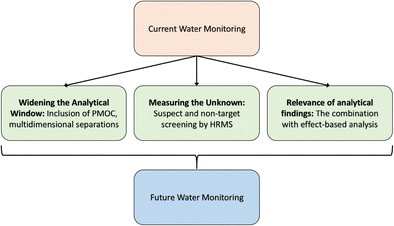Analytical and Bioanalytical Chemistry ( IF 3.8 ) Pub Date : 2018-03-21 , DOI: 10.1007/s00216-018-1015-9 Torsten C. Schmidt
Water analysis has been an important area since the beginning of analytical chemistry. The focus though has shifted substantially: from minerals and the main constituents of water in the time of Carl Remigius Fresenius to a multitude of, in particular, organic compounds at concentrations down to the sub-nanogram per liter level nowadays. This was possible only because of numerous innovations in instrumentation in recent decades, drivers of which are briefly discussed. In addition to the high demands on sensitivity, high throughput by automation and short analysis times are major requirements. In this article, some recent developments in the chemical analysis of organic micropollutants (OMPs) are presented. These include the analysis of priority pollutants in whole water samples, extension of the analytical window, in particular to encompass highly polar compounds, the trend toward more than one separation dimension before mass spectrometric detection, and ways of coping with unknown analytes by suspect and nontarget screening approaches involving high-resolution mass spectrometry. Furthermore, beyond gathering reliable concentration data for many OMPs, the question of the relevance of such data for the aquatic system under scrutiny is becoming ever more important. To that end, effect-based analytics can be used and may become part of future routine monitoring, mostly with a focus on adverse effects of OMPs in specific test systems mimicking environmental impacts. Despite advances in the field of water analysis in recent years, there are still many challenges for further analytical research.

Recent trends in water analysis of organic micropollutants that open new opportunities in future water monitoring. HRMS high-resolution mass spectrometry, PMOC persistent mobile organic compounds
中文翻译:

水分析的最新趋势引发了对有机微量污染物的未来监测
自分析化学开始以来,水分析一直是重要的领域。然而,重点已经发生了实质性的变化:从卡尔·雷米吉乌斯·费森尤斯时代的矿物质和水的主要成分,到如今尤其是浓度低至每升亚纳米级的多种有机化合物。之所以如此,是因为近几十年来仪器仪表领域的众多创新,并简要讨论了其驱动因素。除了对灵敏度的高要求之外,自动化的高通量和较短的分析时间也是主要要求。本文介绍了有机微量污染物(OMP)的化学分析方面的一些最新进展。其中包括分析整个水样中的优先污染物,扩展分析窗口,特别是包括高极性化合物,在质谱检测之前趋向于一个以上分离维度的趋势,以及通过涉及高分辨率质谱的可疑和非目标筛选方法应对未知分析物的方式。此外,除了为许多OMP收集可靠的浓度数据外,这种数据与受到审查的水生系统的相关性问题也变得越来越重要。为此,可以使用基于效果的分析,它可能会成为将来例行监视的一部分,主要侧重于在模拟环境影响的特定测试系统中OMP的不利影响。尽管近年来水分析领域取得了进展,但进一步的分析研究仍面临许多挑战。在质谱检测之前朝着一个以上分离维度发展的趋势,以及通过涉及高分辨率质谱的可疑和非目标筛选方法应对未知分析物的方法。此外,除了为许多OMP收集可靠的浓度数据外,这种数据与受到审查的水生系统的相关性问题也变得越来越重要。为此,可以使用基于效果的分析,它可能会成为将来例行监视的一部分,主要侧重于在模拟环境影响的特定测试系统中OMP的不利影响。尽管近年来水分析领域取得了进展,但进一步的分析研究仍面临许多挑战。质谱检测之前朝着一个以上分离维度发展的趋势,以及通过涉及高分辨率质谱的可疑和非目标筛选方法应对未知分析物的方法。此外,除了为许多OMP收集可靠的浓度数据外,这种数据与受到审查的水生系统的相关性问题也变得越来越重要。为此,可以使用基于效果的分析,它可能会成为将来例行监视的一部分,主要侧重于在模拟环境影响的特定测试系统中OMP的不利影响。尽管近年来水分析领域取得了进展,但进一步的分析研究仍面临许多挑战。以及通过涉及高分辨率质谱的可疑和非目标筛选方法应对未知分析物的方法。此外,除了为许多OMP收集可靠的浓度数据外,这种数据与受到审查的水生系统的相关性问题也变得越来越重要。为此,可以使用基于效果的分析,它可能会成为将来例行监视的一部分,主要侧重于在模拟环境影响的特定测试系统中OMP的不利影响。尽管近年来水分析领域取得了进步,但进一步的分析研究仍面临许多挑战。以及通过涉及高分辨率质谱的可疑和非目标筛选方法应对未知分析物的方法。此外,除了为许多OMP收集可靠的浓度数据外,这种数据与受到审查的水生系统的相关性问题也变得越来越重要。为此,可以使用基于效果的分析,它可能会成为将来例行监视的一部分,主要侧重于在模拟环境影响的特定测试系统中OMP的不利影响。尽管近年来水分析领域取得了进展,但进一步的分析研究仍面临许多挑战。这些数据与受到审查的水生系统的相关性问题变得越来越重要。为此,可以使用基于效果的分析,它可能会成为将来例行监视的一部分,主要侧重于在模拟环境影响的特定测试系统中OMP的不利影响。尽管近年来水分析领域取得了进展,但进一步的分析研究仍面临许多挑战。这些数据与受到审查的水生系统的相关性问题变得越来越重要。为此,可以使用基于效果的分析,它可能会成为将来例行监视的一部分,主要侧重于在模拟环境影响的特定测试系统中OMP的不利影响。尽管近年来水分析领域取得了进展,但进一步的分析研究仍面临许多挑战。

有机微量污染物水分析的最新趋势为将来的水监测开辟了新的机遇。HRMS高分辨率质谱,PMOC持久性移动有机化合物









































 京公网安备 11010802027423号
京公网安备 11010802027423号